
If you are a distributor of surge arrester, we can do OEM production for you;
If you are a factory of surge arrester, we can produce MOV blocks for your MOA. As a leading manufacturer and supplier of surge arrester in China, We can producing all spare parats of lightning arrester, for example, Zno varistor blocks, Sic varistor blocks, Surge arrester body, Bracket and disconnector. Our products have KEMA test certificate. If you are looking for surge arrester manfuactuer, rich pwoer is the best one.
What is Surge arrester?
Surge arrester has another name of lightning arrester. Short name is MOA. It is an electrical appliance used to protect electrical equipment from high transient overvoltage hazards and limit the freewheeling time and often limit the freewheeling amplitude. This term includes any external clearances necessary for the normal function of the appliance during operation and installation, regardless of whether it is a part of a whole. The lightning arrester is usually connected between the grid wire and the ground wire, but sometimes it is also connected near the electrical winding or between the wires. It is suitable for over-voltage protection of transformers, power transmission lines, power distribution panels, switch cabinets, power metering boxes, vacuum switches, parallel compensation capacitors, rotating electrical machines and semiconductor devices.
In short, the function of the lightning arrester is to protect various electrical equipment in the power system from damage caused by lightning overvoltage, operating overvoltage, and power frequency transient overvoltage. The main types of lightning arresters include protective gaps, valve arresters and zinc oxide arresters. The protective gap is mainly used to limit the atmospheric overvoltage, and is generally used for the protection of the power distribution system, the line and the incoming line of the substation. Valve-type arresters and zinc oxide arresters are used for the protection of substations and power plants. In 500KV and below systems, they are mainly used to limit atmospheric overvoltages. In ultra-high voltage systems, they will also be used to limit internal overvoltages or as internal overvoltages.
Features of Surge arrester:
Surge arrester has excellent nonlinear volt-ampere characteristics, good response characteristics, no freewheeling, large current capacity, low residual voltage, strong suppression of overvoltage, pollution resistance, anti-aging, and no altitude constraints. Simple structure, no gap, tight sealing, long life and other characteristics.
The lightning arrester is connected between the cable and the ground, usually in parallel with the protected equipment. The lightning arrester can effectively protect the communication equipment. Once an abnormal voltage occurs, the arrester will act and play a protective role. When the communication cable or equipment is running under the normal working voltage, the arrester will not have any effect, and it is regarded as open circuit to the ground. Once high voltage occurs and the insulation of the protected equipment is endangered, the arrester will act immediately to direct the high-voltage impulse current to the ground, thereby limiting the voltage amplitude and protecting the insulation of communication cables and equipment. When the overvoltage disappears, the arrester quickly returns to its original state, allowing the communication line to work normally.
Therefore, the main function of the arrester is to clip the intruding flowing wave through the parallel discharge gap or nonlinear resistance, reduce the overvoltage value of the protected equipment, and protect the communication line and equipment.
Lightning arresters can be used not only to protect against high voltages generated by lightning, but also to protect against operating high voltages.
Maintenance of Surge arrester:
1, Check the pollution of the surface of the porcelain sleeve of the arrester
when the surface of the porcelain sleeve is seriously polluted, the voltage distribution will be very uneven. In an arrester with shunt resistors in parallel, when the voltage distribution of one of the components increases, the current through its parallel resistors will increase significantly, and the parallel resistors may burn out and cause malfunctions. In addition, it may also affect the arc extinguishing performance of the valve arrester. Therefore, when the surface of the arrester porcelain sleeve is seriously dirty, it must be cleaned in time.
2, Check the lead wire of the arrester and the ground down conductor.
It is possible for the workers to find the invisible defect of the arrester through this inspection. The worker will check whether the upper lead of the arrester is well sealed. Otherwise, any ingress of water and damp can easily cause accidents. Therefore, checking whether the cement joint between the porcelain sleeve and the flange is tight. A waterproof cover can be installed on the lead wire of the 10 kV valve-type arrester to prevent rainwater infiltration; Also need to check the arrester and the protected electrical Whether the electrical distance between the equipment meets the requirements. The lightning arrester should be as close as possible to the protected electrical equipment, the lightning arrester should check the action of the recorder after a thunderstorm; Then check the leakage current, if the power frequency discharge voltage is greater or less than the standard value, it should be overhauled And test; when the discharge recorder has too many movements, it should be overhauled; the porcelain sleeve and cement joints are cracked; when the flange and rubber gasket are off, it should be overhauled.
3, Regularly checking the insulation resistance of the arrester
You will measure it by a 2500 volt insulation shaker. The measured value is compared with the previous result. If there is no obvious change, it can continue to be put into operation. When the insulation resistance drops significantly, it is generally caused by poor sealing and dampness or spark gap short-circuit. When it is lower than the qualified value, you should perform a characteristic test; when the insulation resistance rises significantly, it is generally due to poor contact or fracture of the internal parallel resistance. This will be caused by spring slack and separation of internal components.


